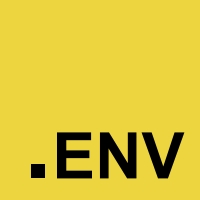dotenv

Dotenv is a zero-dependency module that loads environment variables from a .env file into process.env. Storing configuration in the environment separate from code is based on The Twelve-Factor App methodology.
Install
# with npm
npm install dotenv
# or with Yarn
yarn add dotenvUsage
As early as possible in your application, require and configure dotenv.
require('dotenv').config()Create a .env file in the root directory of your project. Add environment-specific variables on new lines in the form of NAME=VALUE. For example:
DB_HOST=localhost
DB_USER=root
DB_PASS=s1mpl3process.env now has the keys and values you defined in your .env file.
Preload
You can use the --require (-r) command line option to preload dotenv. By doing this, you do not need to require and load dotenv in your application code. This is the preferred approach when using import instead of require.
The configuration options below are supported as command line arguments in the format dotenv_config_<option>=value
Additionally, you can use environment variables to set configuration options. Command line arguments will precede these.
Config
config will read your .env file, parse the contents, assign it to process.env, and return an Object with a parsed key containing the loaded content or an error key if it failed.
You can additionally, pass options to config.
Options
Path
Default: path.resolve(process.cwd(), '.env')
You may specify a custom path if your file containing environment variables is located elsewhere.
Encoding
Default: utf8
You may specify the encoding of your file containing environment variables.
Debug
Default: false
You may turn on logging to help debug why certain keys or values are not being set as you expect.
Parse
The engine which parses the contents of your file containing environment variables is available to use. It accepts a String or Buffer and will return an Object with the parsed keys and values.
Options
Debug
Default: false
You may turn on logging to help debug why certain keys or values are not being set as you expect.
Rules
The parsing engine currently supports the following rules:
BASIC=basicbecomes{BASIC: 'basic'}empty lines are skipped
lines beginning with
#are treated as commentsempty values become empty strings (
EMPTY=becomes{EMPTY: ''})inner quotes are maintained (think JSON) (
JSON={"foo": "bar"}becomes{JSON:"{\"foo\": \"bar\"}")whitespace is removed from both ends of unquoted values (see more on
trim) (FOO= some valuebecomes{FOO: 'some value'})single and double quoted values are escaped (
SINGLE_QUOTE='quoted'becomes{SINGLE_QUOTE: "quoted"})single and double quoted values maintain whitespace from both ends (
FOO=" some value "becomes{FOO: ' some value '})double quoted values expand new lines (
MULTILINE="new\nline"becomes
FAQ
Should I commit my .env file?
.env file?No. We strongly recommend against committing your .env file to version control. It should only include environment-specific values such as database passwords or API keys. Your production database should have a different password than your development database.
Should I have multiple .env files?
.env files?No. We strongly recommend against having a "main" .env file and an "environment" .env file like .env.test. Your config should vary between deploys, and you should not be sharing values between environments.
In a twelve-factor app, env vars are granular controls, each fully orthogonal to other env vars. They are never grouped together as “environments”, but instead are independently managed for each deploy. This is a model that scales up smoothly as the app naturally expands into more deploys over its lifetime.
What happens to environment variables that were already set?
We will never modify any environment variables that have already been set. In particular, if there is a variable in your .env file which collides with one that already exists in your environment, then that variable will be skipped. This behavior allows you to override all .env configurations with a machine-specific environment, although it is not recommended.
If you want to override process.env you can do something like this:
Can I customize/write plugins for dotenv?
For dotenv@2.x.x: Yes. dotenv.config() now returns an object representing the parsed .env file. This gives you everything you need to continue setting values on process.env. For example:
What about variable expansion?
Try dotenv-expand
How do I use dotenv with import?
import?ES2015 and beyond offers modules that allow you to export any top-level function, class, var, let, or const.
When you run a module containing an
importdeclaration, the modules it imports are loaded first, then each module body is executed in a depth-first traversal of the dependency graph, avoiding cycles by skipping anything already executed.
You must run dotenv.config() before referencing any environment variables. Here's an example of problematic code:
errorReporter.js:
index.js:
client will not be configured correctly because it was constructed before dotenv.config() was executed. There are (at least) 3 ways to make this work.
Preload dotenv:
node --require dotenv/config index.js(Note: you do not need toimportdotenv with this approach)Import
dotenv/configinstead ofdotenv(Note: you do not need to calldotenv.config()and must pass options via the command line or environment variables with this approach)Create a separate file that will execute
configfirst as outlined in this comment on #133
Contributing Guide
See CONTRIBUTING.md
Change Log
See CHANGELOG.md
Who's using dotenv?
These npm modules depend on it.
Projects that expand it often use the keyword "dotenv" on npm.
Last updated
Was this helpful?